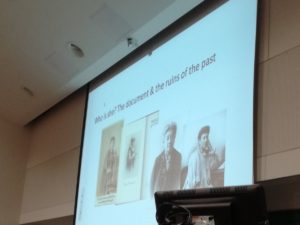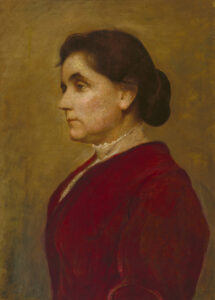
Last July marked another passing of the Association for Documentary Editing’s yearly conference, this time taking place in Washington, D.C. Our nation’s capital has endless museums, attractions, and performances to explore, but there was only one woman I wanted to meet: Jane Addams, of course. The National Portrait Gallery houses the only known full-color image of Addams, painted by George de Forest Brush in 1906, the process of which was detailed in many letters that can be found within the digital edition. It took some work getting to her – the front desk claimed Addams’s portrait was not currently on display even though I had pulled up a location on the Gallery’s website. Not one to be told “no,” I scoured the nooks and crannies of the museum, looking for Jane nestled among peace activists, child or immigrant welfare reformers, or suffrage protesters. Instead, I found her with what I believed to be a sort of motley crew in a section titled “Republic or Empire?” that detailed America’s thoughts on Spain’s involvement in the destruction of the USS Maine. Her fellow portrait sitters included Samuel Clemens, W.E.B. Du Bois, Benjamin Tillman, Moorfield Storey, Queen Lili’uokalani, and Theophilus Gould Steward, gathered together under the roof of “anti-imperialism.” Since visiting the Gallery, I’ve been wondering: Does Jane Addams truly belong among these figures, or would she be better represented elsewhere?
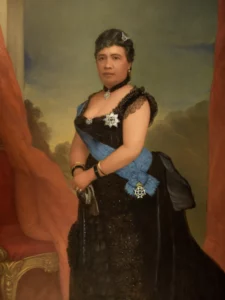
Imperialism was a weighted topic during the early Progressive Era. The Berlin Conference of 1884-85 was convened specifically to regulate European colonization and trade in Africa, and to which the United States sent three diplomats to represent the American colonial empire. In 1887, the US renewed the Hawaiian Reciprocity Treaty of 1875, further increasing American economic influence in Hawaii. This renewal set the stage for the overthrowing of Queen Lili’uokalani, the last reigning sovereign of the Hawaiian Kingdom, in 1893. In the 1890s, the “Scramble for Africa” continued, with Egypt overtaken by the British in 1882, and Sudan, Nigeria, Kenya and Uganda subjugated in the 90’s and early 20th century. These global events culminate in the Gallery section’s primary focus, the 1898 sinking of the USS Maine, then stationed in Havana Harbor, Cuba to protect American interests during the Cuban War of Independence.
Admittedly, I am not an expert in Progressive Era imperialism, but I like to think I know Jane Addams quite well. During the events discussed above, Addams was dutifully creating and strengthening Hull-House, a settlement house in Chicago modeled after Toynbee Hall of London. While she would go on to become active in global circles like peace and disarmament, Addams began her reform work locally, ensuring that marginalized citizens of the Nineteenth Ward were given uplifting amenities and a space to gather and learn. By our records, in the 1890s Addams wrote speeches and articles primarily about Hull-House, working women, and labor strikes – issues that stopped at the state level. Her interest in international affairs wouldn’t manifest fully until the onset of the first World War. Yet, despite all of this, Addams joined the Anti-Imperialist League in 1899.
It was in this same year that Addams gave her first signs of anti-imperial sentiments, with an article for the Central Anti-Imperialist League titled “Democracy or Militarism.” In it, she shows contempt toward countries with “an increased standing army, the soldiers of which are non-producers and must be fed by the workers.” She goes on to scorn the idea of “protecting the weak” as the excuse of a ruler to invade and subjugate outside nations, and shows disapproval toward the recent Spanish-American War. Even so, the last three paragraphs relate the then current state of Spain to events going on in Chicago rather than referencing any national affairs. After this, Addams didn’t discuss imperialism, anti or pro, much, if at all. The next time it was brought up in any meaningful way was a letter from Erving Winslow, Secretary of the Anti-Imperialist League, dated August 12, 1912 in which he chided Addams for supporting Theodore Roosevelt, a known imperialist, in the 1912 Presidential election.
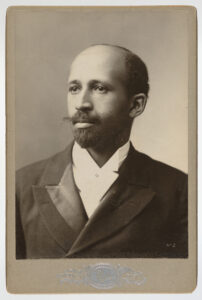
The men Addams was grouped with were, from all accounts, more entrenched in the anti-imperialist scene than Addams ever was. Samuel Clemens was shown to be in favor of imperialism until about 1900. From then until his death in 1910, Clemens spoke and wrote often about his thoughts on the Treaty of Paris and the burgeoning Philippine-American War, and he was vocally critical of foreign countries’ imperialism as well. Du Bois extensively advocated for anti-imperialism, especially in Africa where, he argued, the Scramble for Africa was the foundation for World War I. Tillman was a staunch anti-imperialist, though his sentiments stemmed from the belief that white American lives were being wasted in the pursuit of militaristically subduing Filipino natives after the Spanish-American War. Moorfield Story was the Anti-Imperialist League’s second and last president from 1905-1920, and believed in a connection between America’s imperialistic endeavors and the country’s persecution of minority races. Queen Lili’uokalani had the most direct impact of the Age of Imperialism, deposed in 1893 by a group of sugar and pineapple businessmen. If Lili’uokalani was the most directly impacted, Steward was the least involved. Theophilus Gould Steward was primarily a clergyman, author, and educator, serving as a chaplain in the 25th Infantry Regiment, a racially segregated regiment, from 1891-1907, including serving in Cuba during the Spanish-American War, and later in the Philippines. Steward wrote about the experience of the African American soldier, which did touch on their struggle for freedom and citizenship, but he did not directly compare their strife to Filipinos resisting American colonial rule.
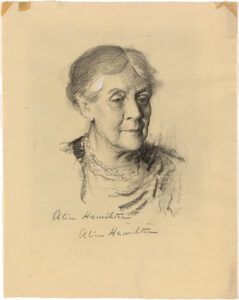
If not here, then where would Jane Addams belong? The National Portrait Gallery holds over 20,000 pieces in their various collections – certainly some of those could fit better with Addams’s narrative. To represent women building Chicago, they own a portrait of Frances Perkins, the first woman to serve on a cabinet of a US President and a Hull-House volunteer, Alice Hamilton, a Chicago doctor and Hull-House volunteer, or Nettie Fowler McCormick, a Chicago philanthropist. In a wider perspective, outside her Chicago colleagues, there is Woodrow Wilson, 28th President of the United States, Martha Carey Thomas, second president of Bryn Mawr College, and Julius Rosenwald, co-owner of Sears, Roebuck, and Co. and philanthropist.
At the end of the day, Jane Addams’s portrait is no longer on display. Neither Clemens’s, Du Bois’s, Tillman’s, Storey’s, Lili’uokalani’s, or Steward’s portraits are currently available to view in person. I suppose that is the nature of a large collection of works with limited space to display them. Even so, this also means that Addams could be displayed along with any number of her peers at any point in time, perhaps to help tell an entirely different story about America’s elaborate history.
Victoria Sciancalepore
Assistant Editor
Other Sources: “Berlin West Africa Conference.” Encyclopædia Britannica, February 19, 2024. https://www.britannica.com/event/Berlin-West-Africa-Conference; Hixson, William B. Moorfield Storey and the Abolitionist Tradition. New York, NY: Oxford University Press, 1972; Jane Addams. “Democracy or Militarism.” Liberty Tracts, no. 1 (1899): 35–39; “Joint Resolution to Provide for Annexing the Hawaiian Islands to the United States (1898).” National Archives and Records Administration, February 8, 2022. https://www.archives.gov/milestone-documents/joint-resolution-for-annexing-the-hawaiian-islands; Lewis, David Levering. W.E.B. Du Bois. New York: H. Holt, 1993; “Maine Blown Up at Havana.” New York Tribune. February 16, 1898; Steward, Theophilus Gould. The Colored Regulars. Philadelphia, PA: A.M.E. Book Concern, 1904; Tillman, Benjamin. “Policy Regarding the Philippine Islands.” Congressional Record 32, no. 2 (February 21, 1899): 1529–33; Twain, Mark. “To the Person Sitting in Darkness.” The North American Review 172, no. 531 (February 1901): 161–76.

Victoria Sciancalepore is the Assistant Editor at the Jane Addams Papers Project located at Ramapo College of New Jersey, funded by the NEH, NHPRC, and the Delmas Foundation. She is currently editing the Jane Addams Papers Digital Edition and The Selected Papers of Jane Addams Volumes 4 and 5 (forthcoming). She is also a project manager at the digital edition of The Penny Colman Collection of Historical Landmarks of Women. Victoria has been a member of the Association for Documentary Editing since 2016 for which she has given several presentations at its annual conferences and contributes to its newsletter. Previously, she was a transcription assistant at the Margaret Sanger Papers Project at New York University.




 Cathy led off the panel talking about the “Big Picture: Conceiving a Digital Edition of Jane Addams’ Papers,” providing a short history of the Addams Papers microfilm and book projects, and the process that went into deciding to digitize the microfilm edition. The decisions to be made involved thinking through the audience for the edition and what kinds of tools and resources they needed. In addition, Cathy discussed the decision to use the Omeka database-driven platform for the digital edition rather than using text encoding using XML. Going with a web-publishing friendly system allowed the Addams Papers to design a site that not only provides deep metadata, but also manages the project’s internal workflow, tracking information on each document as it passes through our permissions and copyright checks, metadata and transcription, and proofreading. Cathy also talked about her desire to see the Addams Papers edition be flexible enough that scholars and students can use its materials to build their own research projects.
Cathy led off the panel talking about the “Big Picture: Conceiving a Digital Edition of Jane Addams’ Papers,” providing a short history of the Addams Papers microfilm and book projects, and the process that went into deciding to digitize the microfilm edition. The decisions to be made involved thinking through the audience for the edition and what kinds of tools and resources they needed. In addition, Cathy discussed the decision to use the Omeka database-driven platform for the digital edition rather than using text encoding using XML. Going with a web-publishing friendly system allowed the Addams Papers to design a site that not only provides deep metadata, but also manages the project’s internal workflow, tracking information on each document as it passes through our permissions and copyright checks, metadata and transcription, and proofreading. Cathy also talked about her desire to see the Addams Papers edition be flexible enough that scholars and students can use its materials to build their own research projects.

